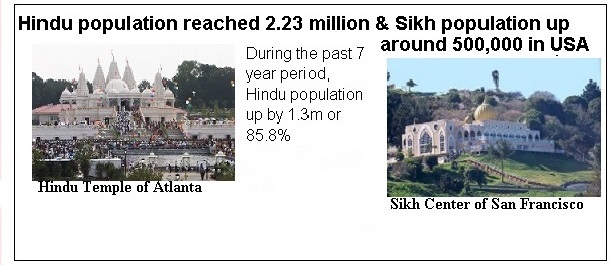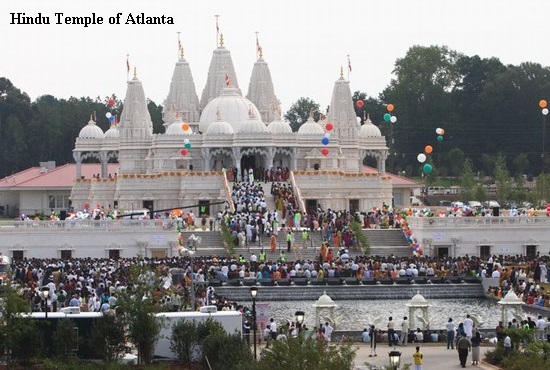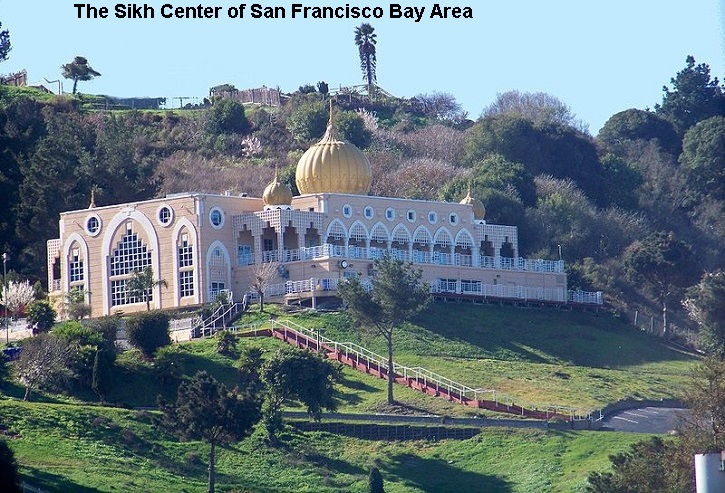| Connecting
over 25 millions NRIs worldwide |
|
|||||||||||||||||||||||
|
||
Hindu population up in US, becomes fourth-largest faith By Arul Louis The proportion of Hindus in the US population rose from 0.4 percent in 2007 to 0.7 percent last year, according to the Pew Research Center’s “Religious Landscape Study” published Tuesday. The study only gave the percentage shares of Hindus in the population, rather than numbers, but calculations by IANS using the population proportions in the report and census projections showed that the number of Hindus rose from 1.2 million in 2007 out of a total US population of 301.2 million that year to 2.23 million in 2014 in a population of 318.88 million. This amounts to an increase of 1.03 million or 85.8 percent in the Hindu population during the seven-year period.
An earlier report from Pew on the future of world religions in April said that by 2050, Hindus would make up 1.2 percent of the US population and number 4.78 million. This would make the US Hindu population the fifth largest in the world. Even as some American Christian organisations push for proselytisation in India, their share of the US population fell by 7.8 percent during the seven-year period, from 78.4 percent in 2007 to 70.6 percent last year, the Pew study said. That works out to about 11 million fewer Christians. However, “Christians remain by far the largest religious group in the United States, but the Christian share of the population has declined markedly,” the report said. Underlying the change, there was a marked increase in the number of people who say they have “no particular religion,” the study reported. About 23 percent of American adults fell into this category, up seven percent from the 16 percent in 2007. Included in this broad category are atheists who make up 3.1 percent of the total US population and agnostics, four percent. Compared to Christianity, the others are miniscule despite the increases. The second largest religion is Judaism, which accounts for 1.9 percent of the population, with an increase of 0.2 percent, the study found. It is followed by Islam with a 0.9 percent share of the population, up by 0.5 percent. Buddhism ties for the fourth place with Hinduism at 0.7 percent. The rising trend of Hinduism in the US contrasts with that in India. The Pew report released in April said that the share of Hindus in the Indian population was expected to decline by 2.8 percent, from 79.5 percent in 2010 to 76.7 percent in 2050 even though their numbers were projected to grow to almost 1.3 billion by that year in a total Indian population of nearly 1.7 billion. The new report Tuesday on the religions in the US said that most of the increase in the Hindu population came through immigration and not conversions: 87 percent are immigrants and nine percent are the children of immigrants, the report said. Only 10 percent of the Hindus are converts, with Catholics and unaffiliated each accounting for 3 percent. Hindus are least likely to convert to other religions, according to the report: Of all the America adults who said they were raised as Hindus, 80 percent continued to adhere to Hinduism. Of those born Hindu, who did not any longer identify themselves as Hindus, 18 percent said they had no religious affiliation (a category that includes atheists and agnostics), and only one percent joined Christian Protestant sects. Rajan Zed, the Nevada-based president of the Universal Society of Hinduism, attributed the high retention rate of Hinduism to “the focus on inner search, exploring the vast wisdom of scriptures and making spirituality more attractive to youth and children.” Referring to the social and economic attributes of Hindus reported in the Pew study, told IANS, “The Hindu community in America is continuing with the traditional values of hard work, higher morals, stress on education, and sanctity of marriage amidst so many distractions.” These are the highlights of the Hindu community profile in the report:
An anomaly in the report is that 62 percent of Hindus are men and 38 percent women, a difference of 24 percent, which may be due to the pattern of immigration……..IANS By NRIpress-Club Sikh population up around 500,000 in USAIn Dec., 2014, based on a study of attendance at Gurdwaras in US, NRIpress-club members made survey and conclude that there are more than 500,000 Sikh in USA. The 2010 Religious Congregations & Membership Study finds that there are 246 Sikh congregations, (SIKH TEMPLES-gurdwaras).
In 2007, there were estimated to be 250,000 Sikhs living in the United States. The World Religion Database at Boston University estimates there are about 280,000 Sikhs in the U.S., based on estimates of the number of Punjabi immigrants from India and Pakistan and an assumption about the proportion of them who are Sikh. Sikh communities exist on every inhabited continent, with the largest emigrant population being in Canada, with slightly more than in the United Kingdom. There are approximately 30 million Indian Muslims in USA From the 1880s to 1914, several thousand Muslims immigrated to the United States from the former territories of the Ottoman Empire and the former Mughal Empire. The Muslim population of the U.S. increased dramatically in the 20th century and 2010 survey estimate over 2.6m. 2.6m in 20102.6m in 2010
|
||
| |
|
|



